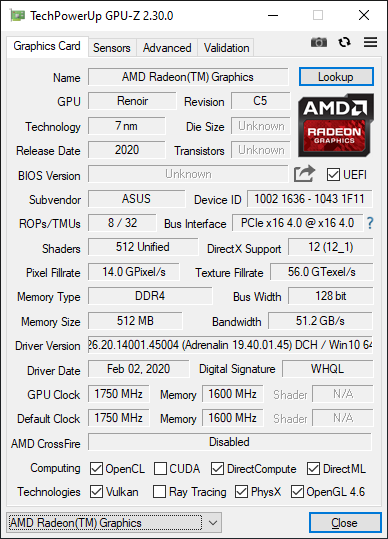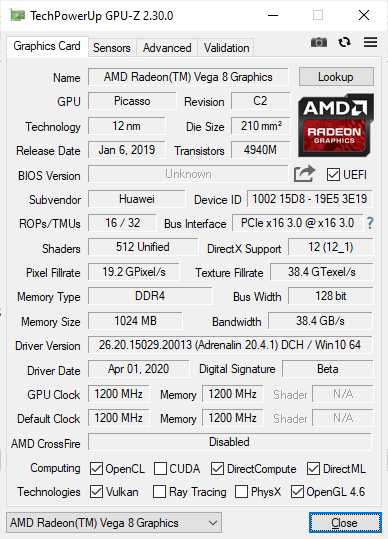AMD’s Mobile Revival: Redefining the Notebook Business with the Ryzen 9 4900HS (A Review)
by Dr. Ian Cutress on April 9, 2020 9:00 AM ESTTesting the Ryzen 9 4900HS Integrated Graphics
Under the hood of the Ryzen 9 4900HS, aside from the eight Zen 2 cores, is an enhanced Vega 8 graphics solution. For this generation of mobile processors, AMD is keeping the top number of compute units to 8, whereas in the previous generation it went up to Vega 11. Just by the name, one would assume that AMD has lowered the performance of the integrated graphics. This is not the case.
For the new Ryzen Mobile 4000 processors, the Vega graphics here are enhanced in three main ways over the previous generation. First is that it is built on the 7nm process node, and AMD put a lot of effort into physical design, allowing for a more optimized version that has a wider voltage/frequency window compared to the previous generation. Secondly, and somewhat connected, is the frequency: the new processors top out at 1750 MHz, rather than 1400 MHz, which would naturally give a simple 25 % boost with all other things being equal. Third on the list is memory, as the new platform supports up to DDR4-3200, rather than DDR4-2400, providing an immediate bandwidth boost which is what integrated graphics loves. There’s also the nature of the CPU cores themselves, having larger L3 caches, which often improves integrated graphics workloads that interact a lot with the CPU.
Normally, with the ASUS Zephryus G14, the switching between the integrated graphics and the discrete graphics should be automatic. There is a setting in the NVIDIA Control Panel to let the system auto-switch between integrated and discrete, and we would expect the system to be on the IGP when off the wall power, but on the discrete card when gaming (note, we had issues in our battery life test where the discrete card was on, but ASUS couldn’t reproduce the issue). In order to force the integrated graphics for our testing, because the NVIDIA Control Panel didn’t seem to catch all of our tests to force them onto the integrated graphics, we went into the device manager and actually disabled the NVIDIA graphics.
This left us with AMD’s best integrated graphics in its Ryzen Mobile 4000 series: 1750 MHz of enhanced Vega 8 running at DDR4-3200.

Renoir with Vega 8 – updated to 20.4 after this screenshot was taken
Our comparison point here is actually a fairly tricky one to set up. Unfortunately we do not have a Ryzen 7 3750H from the previous generation for comparison, but we do have an Honor Magicbook 14, which has a Ryzen 5 3500U.
This is a 15 W processor, running at 1200 MHz and DDR4-2400, which again makes the comparison a little tricky, but it is better than comparing it to the Intel HD630 graphics in the Razer Blade.
We also re-ran the benchmarks on the latest drivers with AMD's 65 Desktop APUs, the Ryzen 5 3400G (with Vega11) and the Ryzen 3 3200G (with Vega 8). These are running at DDR4-2933, the AMD maximum officially supported by these APUs (which means anything above this is overclocking).


This is a pretty substantial difference, no joke.



Hopefully we will get more variants of the Ryzen integrated graphics to test, along with an Ice Lake system.











267 Comments
View All Comments
XabanakFanatik - Thursday, April 9, 2020 - link
There's something off about the Cinebench R20 scores. The 4900H is scoring around 50% higher than it should and the 9750 is around 35% higher than it should.XabanakFanatik - Thursday, April 9, 2020 - link
It looks like the scores from the PCMark 10 Creation graph ended up in the CB15 graph as well.XabanakFanatik - Thursday, April 9, 2020 - link
The new graph showing the 4900HS scoring 2000 points doesn't seem right, either. There's no way the 9750 scored over 4000.T1beriu - Thursday, April 9, 2020 - link
Ian, you might wanna correct the CB R20 graph.ballsystemlord - Thursday, April 9, 2020 - link
@Ian there's only one CB R20 chart. It doesn't say ST or MT.ballsystemlord - Thursday, April 9, 2020 - link
Its here! Its finally here! An AT AMD 4000 series laptop review!Slash3 - Thursday, April 9, 2020 - link
Great article.Any idea if there are 4900U (or 4900HS) models built with LPDDR4X-4266? Would be very interesting to see any gains to the integrated graphics vs the traditional DDR4 subsystem, especially for a 4900U without a separate discrete GPU.
It would also be interesting to know whether an LPDDR4X-4266 platform would feature a 1:1 FCLK of 2133MHz, something well above the current capabilities of desktop Zen 2 chips (typically topping out at 1900MHz).
Lenovo's forthcoming Thinkpad X13 might be another good one to look into, as it should feature both the 4000-series mobile Ryzen as well as Thunderbolt, a feature that seems to be missing on the majority of this current release wave.
neblogai - Thursday, April 9, 2020 - link
TB was just reported on Notebookcheck to be actually absent in Lenovo Renoir laptops.Slash3 - Thursday, April 9, 2020 - link
Well that's pretty disappointing if true. The PDFs in their article link to older T14 variants but it should be pretty easy to get confirmation on the X13 when they end up in people's hands over the next few weeks.Bummer. :(
Fataliity - Friday, April 10, 2020 - link
The LPDDR4X-4266 is actually worse than the DDR4 3200. It consumes way less power, but has way higher latency. The 3200 is best for the IGP.